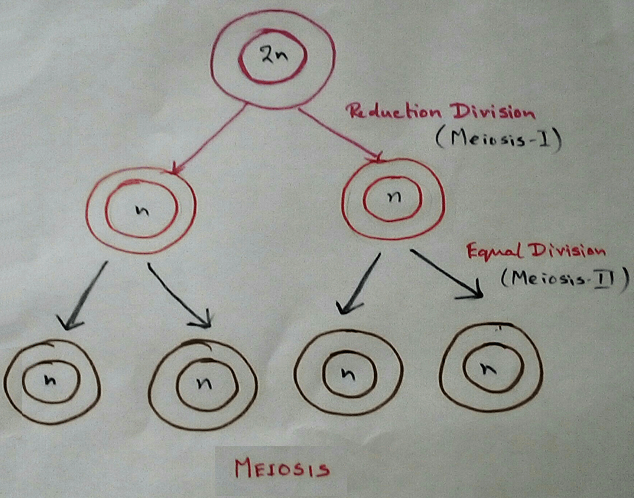Meiosis Cell Division
Definition of Meiosis: Meiosis is a complex cell division process in which the diploid number of chromosome of the mother cell is reduced to haploid number of chromosomes in the four daughter cell.
Importance for Meiosis: meiotic cell division is associated with the conservation of the chromosome number of the species. It influences the adaptation and evolution of organisms. Variations are observed in new offspring.
Occurrence: It is observed in the eukaryotic diploid germ cells of the sex organs of the plants and animals. The meiocyte of the plant cells are called sporocytes (micro sporocytes in male plant and megasporocytes in female plant). In animals, meiocyte of gonads are called monocytes, which may be spermatocytes in male and pictures in female.
Types of meiotic cell division: Meiotic cell division can be classifieds into three types on the basis of the type of cell, where it is occured-
1. Zygotic or initial meiosis - This the process of meiosis which takes place immediately after the formation of zygote by Sunday. It is observed in lower plants like diatom, certain fungi and sporozoa.
2. Gametic or terminal meiosis - Process of meiosis occur at the time of gamete formation (spermatogenesis and oogenesis). It is observed in lower plants and higher animals.
3. Sporic or intermediary meiosis - This type of meiosis occurs at the process formation in lower plants as well as flowering plants by microsporogenesis.
Factors affecting meiosis- Factors that affect meiosis are follows-
1. Completion of vegetative growth.
2. Maturation of sex organs.
3. Due to the disbalance of nucleic acids and certain hormones.
4. When there is increase in the amount of DNA and RNA.
Process of Meiosis - The process of meiosis cell division is made up of two stages. They are – 1st meiotic cell division and 2nd meiotic cell division.
First meiotic cell division is known as heterotypic division which is associated with the reduction of chromosome numberand second meiotic division is also called mitosis due to equal division as it gives birth to the four haploid number of chromosome from two haploid parent cell. It is also called homotypic division or equational division.
First meiotic division is consists of prophase I, prometaphase I, metaphase I, anaphase I, telophase I. This subphages are associated together to called karyokinesis. After karyokinesis or nucleus division, cytoplasm division or cytokinesis takes place.
Prophase I is also made up of leptotene, zygotene,pachytene, diplotene, diakinesis sub stages.
Second meiotic division is consists of prophase ,metaphase, anaphase, telophase.
Questions and Answers on Meiosis Cell Division:
1. What do you mean by cytokinesis?
Cleavage and division of cytoplasm is called cytokinesis.
2. What do you mean by meiocyte?
Any cell which is under going meiotic cell division is called meiocyte.
3. Why there is combination of characteristics observed in the meiosis?
Combination of characteristics are observed due to the crossing over which takes place during pachytene sub stage of first meiotic cell division.
4. What is synaptic knot?
In case of plant cell ,the chromosomes clump at one side of the nucleus is called synthesis or synaptic knot.
From Meiosis Cell Division to HOME PAGE
Recent Articles
-
Explain about Growth in Plants |Definition of Growth & Differentiation
Feb 27, 25 02:07 PM
Growth is a permanent increase in length or volume of an organism that brought upon by an increase in its dimensions due to synthesis of new protoplasmic material. -
Definition of Respiratory Quotient | calculation | Application | Plant
Dec 02, 24 12:09 AM
Definition of respiration quotient- the ratio of the carbon-dioxide evolved to that of the oxygen consumed by a cell, tissue, plants or animals in a given time is called respiratory quotient. It is us… -
Amphibolic Pathway | Definition | Examples | Pentose Phosphate Pathway
Jun 06, 24 10:40 AM
Definition of amphibolic pathway- Amphibolic pathway is a biochemical pathway where anabolism and catabolism are both combined together. Examples of amphibolic pathway- there are different biochemical… -
Respiratory Balance Sheet | TCA Cycle | ATP Consumption Process
Feb 18, 24 01:56 PM
The major component that produced during the photosynthesis is Glucose which is further metabolised by the different metabolic pathways like glycolysis, Krebs cycle, TCA cycle and produces energy whic… -
Electron Transport System and Oxidative Phosphorylation | ETC |Diagram
Feb 04, 24 01:57 PM
It is also called ETC. Electron transfer means the process where one electron relocates from one atom to the other atom. Definition of electron transport chain - The biological process where a chains…













New! Comments
Have your say about what you just read! Leave me a comment in the box below.